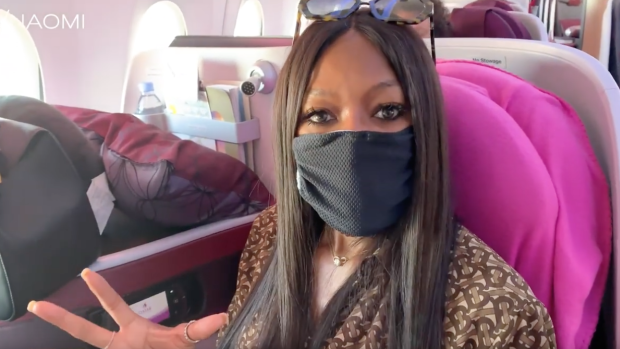This was published 4 years ago
Travelling and coronavirus, flu, colds: How to prevent getting sick on a plane
By Dawn Gilbertson

Naomi Campbell sports her anti-air pollution facemask.Credit: YouTube
Winter travel is hazardous enough during cold and flu season and the persistent threat of weather woes, and this year travellers have an added worry: a coronavirus outbreak in China.
Health authorities will be implementing screening measures for passengers flying direct from Wuhan to Sydney after a man was being tested for the virus after flying from China to Brisbane .
While the risk may be low, it doesn't mean travellers should not take added precautions to stay healthy at 30,000 feet.
What's a traveling germophobe to do on a plane?
1. Wash your hands often, with soap and water for at least 20 seconds. The CDC (Centers for Disease Control and Prevention) says it is the single most important infection control measure, and it lists it first among the guidelines for preventing the spread of disease on commercial aircraft.
2. Carry alcohol-based hand sanitiser (the CDC recommends at least 60% alcohol) in case water isn't nearby.
3. Avoid touching your eyes, nose and mouth with unwashed hands, the CDC tells flight crews and passengers.
4. Keep the air vents above your seat open to improve ventilation. Frequent flier and travel analyst Henry Harteveldt of Atmosphere Research in San Francisco says he points the open vent to blow air away from him on every flight.
5. Wipe down the arm rests and tray table with sanitary wipesand bring tissues to open the bathroom door.
6. Bring a face mask in case you're seated next to someone coughing or sneezing. Harteveldt doesn't use one but says it's become routine for many passengers following the SARS epidemic in 2003. The CDC recommends flight crews use them when dealing with sick passengers with respiratory symptoms.
7. Pick a window seat and don't budge. That was among the recommendations from a study published in March 2018 about how respiratory viruses spread on planes.
8. Ask a flight attendant if it's possible to switch seats to move away from a sick passenger. The same March study found that passengers within two seats or a row of a passenger with a respiratory illness have an 80% or greater possibility of getting sick, CNN reported.
9. Consult the Travellers' Health section of the CDC's website for advisories and advice on travelling around the world. You can filter by destination and the type of traveller you are, from a family with children to someone with a chronic disease.
10. Do your fellow travellers a favour and don't fly when you're really sick. The CDC recommends travellers stay home a minimum of 24 hours after a fever subsides. But what about those nasty airline ticket change fees ($200 plus any fare difference is common), you say? Two potential ways around them: buy travel insurance when you book your ticket (you won't be covered if you buy it after you get sick) or kindly explain your situation to an airline customer service representative (offering a note from your doctor) and hope for a one-time waiver. Southwest Airlines is the only major airline that does not charge ticket change fees on non-refundable tickets. Travellers receive a credit to use toward a future flight (at prevailing airfares, of course.)
Sign up for the Traveller newsletter
The latest travel news, tips and inspiration delivered to your inbox. Sign up now.